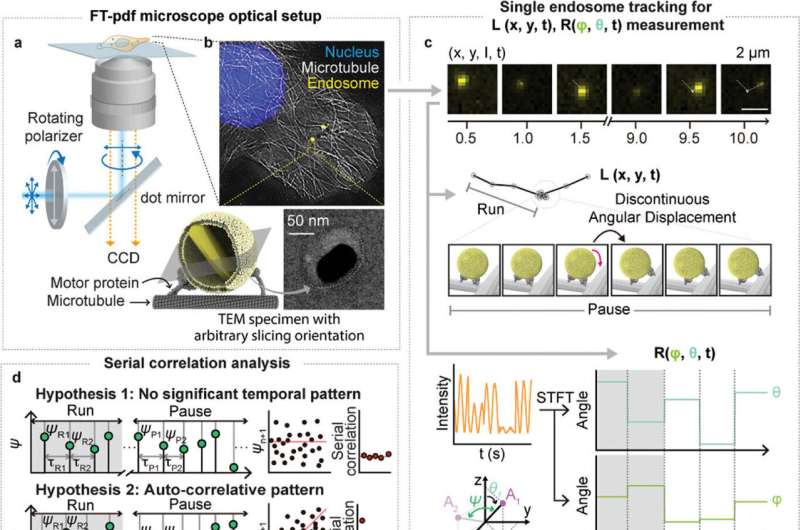This article has been reviewed according to Science X's editorial process and policies. Editors have highlighted the following attributes while ensuring the content's credibility:
fact-checked
peer-reviewed publication
proofread
Successful observation of endosome behavior provides new clues for disease treatment

A team led by Professor Seo Dae-ha of the Department of Physics and Chemistry at DGIST has developed new real-time microscopy technology and successfully observed the behavior of "motor proteins," which may hold the key to unraveling the efficient material transport strategy of cells.
The research team used nanoparticle probe, high-resolution microscopy, and Fourier transform algorithm technologies to develop "Fourier transform-based plasmonic dark-field microscopy" (FT-pdf microscopy) with positional and angular accuracy comparable to electron microscopy, achieving the highest level of existing optical microscopy. The study is published in the journal Advanced Science.
Cells transport materials efficiently through intracellular vesicles called endosomes. Materials are transported to their destination by motor proteins that move along a complex network of microtubules.
Observing the movement and rotation of endosomes appearing in the transport process provides important information for understanding how intracellular transport is efficiently regulated, which in turn helps elucidate cell functions and diseases.
To visualize this transport process, the research team developed FT-pdf microscopy that performs analysis with the Fourier transform technique using nanoparticles that have "polar angle dependence."
Images of the scattering signals observed by rotating polarized light are continuously captured over a long period of time, and when combined with existing single-particle tracking technology, the movement and rotation of particles can be observed in real time.
Using a plasmonic dark-field microscope, the research team discovered temporal patterns (high time-series characteristics) in the rotational movements of endosomes in cells, which they interpreted as similar to the reinforcement learning strategy of navigation robots or internet search engines.
The real-time strategy of endosome transport can be analyzed and applied to disease cell models to explain and diagnose the cause of diseases.
□ "As shown in this study, ordinary cells that make up the human body seem to be equipped with the data learning technology of robots that humans are actively developing," said Prof. Seo of the Department of Chemical Physics at DGIST.
"This molecular-level strategy holds the key to precise material transport and is another research topic. Our research result is expected to contribute to the understanding and diagnosis of diseases in the future through its application to diseased cells," Prof. Seo added.
More information: Siwoo Jin et al, Temporal Patterns of Angular Displacement of Endosomes: Insights into Motor Protein Exchange Dynamics, Advanced Science (2024). DOI: 10.1002/advs.202306849
Journal information: Advanced Science
Provided by DGIST (Daegu Gyeongbuk Institute of Science and Technology)




















